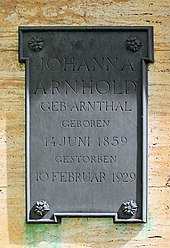Eduard Arnhold
This article includes a list of general references, but it remains largely unverified because it lacks sufficient corresponding inline citations. (February 2021) |



Eduard Arnhold (10 June 1849 – 10 August 1925) was a German entrepreneur, patron of the arts and philanthropist.
Life[]
Born in Dessau, Arnhold was the son of the jewish doctor Adolph Arnhold (1808-1872) and his wife Mathilde Arnhold née Cohn (1826-1905). The later bankers and were his brothers.
In the second half of the 19th century, Arnhold succeeded in his entrepreneurial rise to the top circles of Berlin, taking over almost the entire trade in Silesian bituminous coal on the Berlin market into his hands, which, among many other honorary posts, saw him rise to become a member of the supervisory board of the Dresdner Bank. In 1913, Wilhelm II, German Emperor appointed him as the first and only Jew to the Preußisches Herrenhaus. That he, as a non-converted Jew was "offered" a title of nobility, which he rejected, is a legend that originated in the 1920s, is not substantiated and is now regarded as improbable by researchers.[1]
The enthusiastic art collector invested most of his inherited and earned personal wealth in art and artists, many of whom belonged to his circle of friends, among others Max Liebermann, Arnold Böcklin, Adolph Menzel and Louis Tuaillon. Thus, he was at the same time Berlin's greatest patron of the arts in his time and in 1913 donated the Villa Massimo in Rome as a cultural institute to the Kingdom of Prussia. The Villa Massimo is now run by the Federal Republic of Germany, and selected artists still receive scholarships and accommodation there. The "Stiftung Eduard Arnhold Hilfsfonds" in the care of the Academy of Arts, Berlin also still grants scholarships for visual artists today.
In addition to his villa on Wannsee and a city flat, he acquired the manor near Werneuchen at the turn of the century. He redesigned the park there into a sculpture park and brought together works of art by numerous contemporary artists, but also found objects from distant countries. In the park, for example, he had a marble fountain built that had been excavated in Herculaneum on Mount Vesuvius.
In addition to art, Arnhold was also socially committed. In 1907, he donated the in Werftpfuhl, neighbouring Hirschfelde, named after his wife. In this orphanage for girls, the protégés received an education both in the arts and with a perspective for the labour market.
From 1880, Arnhold was a member of the Society of Friends. Between 1911 and 1925, he was a member of the Senate of the Kaiser Wilhelm Society.


Arnhold died in 1925 at the age of 76 in Neuhaus am Schliersee. His grave is located at the in Wannsee. He rests there at the side of his wife Johanna Arnhold née Arnthal (1859-1929). In front of the grave wall with inscription plaques is a sculpture by depicting a farewell scene.[2] By decision of the Senate of Berlin, the final resting place of Eduard Arnhold (grave location Li AT FW-38) has been dedicated as an honorary grave of the State of Berlin since 1992. The dedication was extended in 2018 for the usual period of twenty years.[3]
References[]
- ^ Kai Drewes: Jüdischer Adel. Nobilitierungen von Juden im Europa des 19. Jahrhunderts. Campus Verlag, Frankfurt 2013, pp 47 f., pp. f.
- ^ Hans-Jürgen Mende: Lexikon Berliner Begräbnisstätten. Pharus-Plan, Berlin 2018, ISBN 978-3-86514-206-1, p. 659.
- ^ Ehrengrabstätten des Landes Berlin (as of November 2018). (PDF, 413 kB) Senatsverwaltung für Umwelt, Verkehr und Klimaschutz, p. 2; retrieved 16 February 2021. Anerkennung und weitere Erhaltung von Grabstätten als Ehrengrabstätten des Landes Berlin. (PDF, 369 kB). Abgeordnetenhaus von Berlin, Drucksache 18/14895 vom 21 November 2018, p. 1 und Anlage 2, p. 1; retrieved 16 February 2021.
Further reading[]
- Johanna Arnhold: Eduard Arnhold. Ein Gedenkbuch. self-published, Berlin 1928.
- Peter von Becker: Eduard Arnhold. Reichtum verpflichtet – Unternehmer und Kunstmäzen. (Jüdische Miniaturen, Band 237.) Hentrich & Hentrich, Berlin / Leipzig 2019, ISBN 978-3-95565-321-7.
- Deutsche Akademie Villa Massimo (ed.): Eduard Arnhold. Accademia Tedesca Villa Massimo, Rome 1988.
- Michael Dorrmann: Eduard Arnhold (1849–1925). Eine biographische Studie zu Unternehmer- und Mäzenatentum im Deutschen Kaiserreich. Akademie-Verlag, Berlin 2002, ISBN 3-05-003748-2.
- Adolf Harnack: Gedächtnisrede bei der Trauerfeier für Herrn Geheimen Kommerzienrat Eduard Arnhold am 15. August 1925. Holten, Berlin 1925.
- Sven Kuhrau: Der Kunstsammler im Kaiserreich. Kunst und Repräsentation in der Berliner Privatsammlerkultur. Ludwig, Kiel 2005, ISBN 3-937719-20-2.
- Dietrich Nummert: Jagd nach Reichtum, Jagd auf Kunst. Kaufmann Eduard Arnhold. In Berlinische Monatsschrift (Luisenstädtischer Bildungsverein). Issue 6, 1999, ISSN 0944-5560, pp. 64–69 Portrait on luise-berlin.de).
- Angela Windholz: Villa Massimo. Zur Gründungsgeschichte der Deutschen Akademie in Rom und ihrer Bauten. Michael Imhof, Petersberg 2003, ISBN 3-935590-93-8.
External links[]
| Wikimedia Commons has media related to Eduard Arnhold. |
- Literature by and about Eduard Arnhold in the German National Library catalogue
- Eduard Arnhold
- 19th-century German businesspeople
- 20th-century German businesspeople
- German patrons of the arts
- German art collectors
- Jewish art collectors
- German Quakers
- Members of the Prussian House of Lords
- 20th-century art collectors
- 1849 births
- 1925 deaths
- People from Dessau-Roßlau
- People of German-Jewish descent